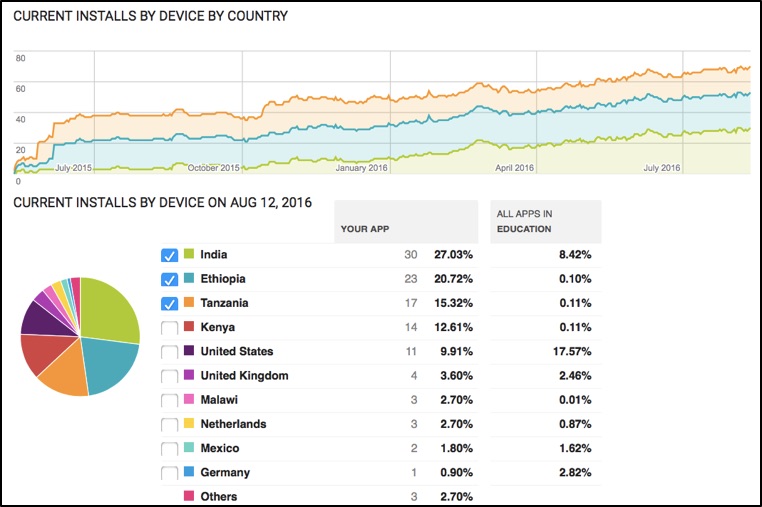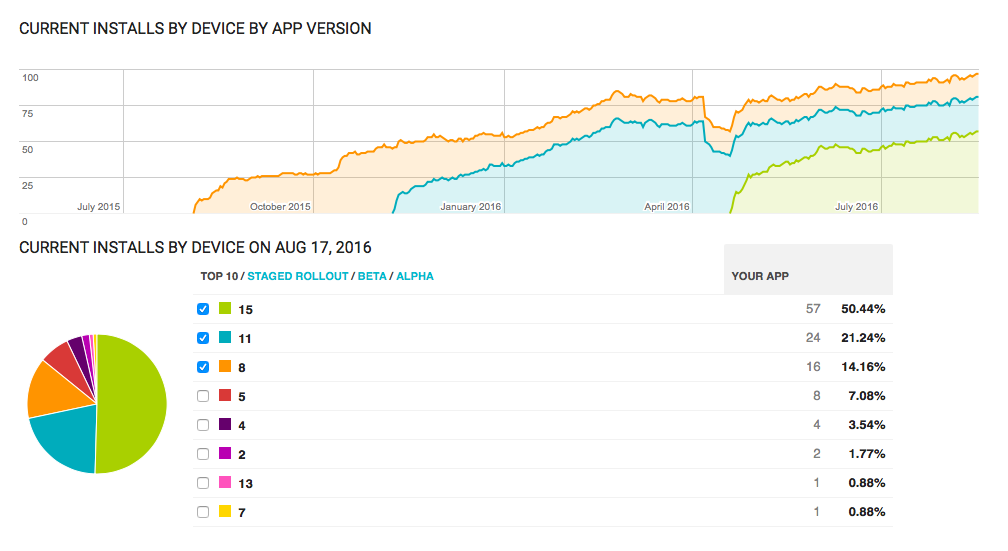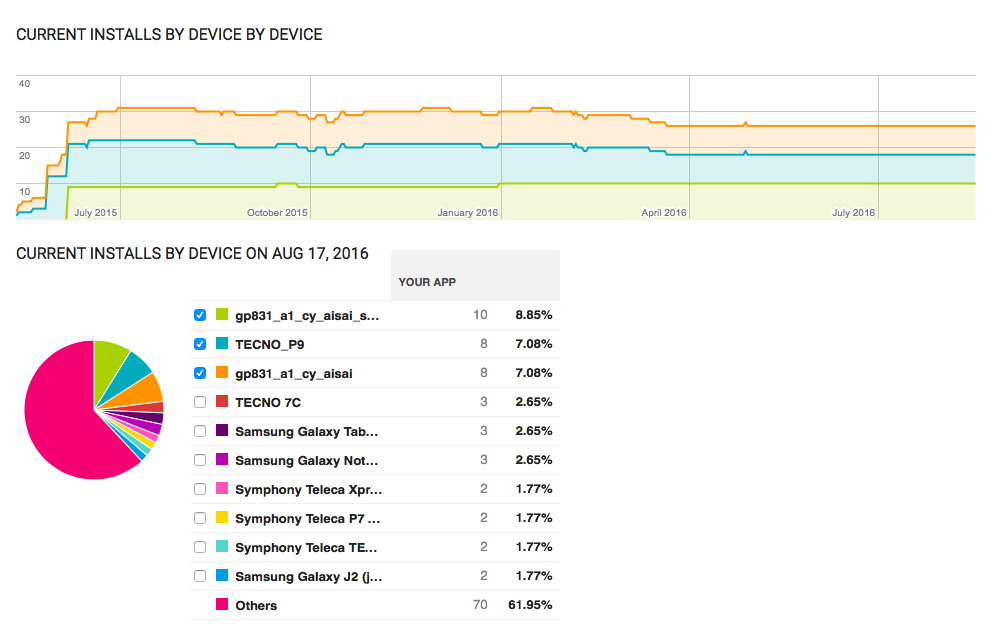What the Data Tells Us About our Self Help Group App Community
Over the two and a half years that our Self Help Group (SHG) app has supported facilitators of this high-impact program model, we have seen our user community grow to almost one thousand users. As we look to the future to plan how to further improve the resource, we wanted to share and summarize how and where the app has been used to date.
The Self-Help Group app is a digital resource for facilitators who are actively learning facilitation skills and mobilizing and mentoring active SHGs. If you’re not familiar with the SHG model, we’ve summarized it briefly below before exploring what the data tells us about our community of users.
A Quick Introduction to Self Help Groups
Self-Help Groups are microsavings and microcredit groups who voluntarily come together, both for social support and to provide the group with savings and access to credit for their businesses or income-generating activities.
They usually comprise about 15 members who meet weekly, buying shares in a joint savings pool that grows substantially over time and is used to give business loans to members with interest. Members also typically pay into a social fund that is used to give emergency loans to members for personal reasons, interest free.
SHGs differ from another savings and credit group model called Volunteer Savings and Loan Associations (VSLAs), most significantly because the group stays together over many years and does not pay out the join savings pool, but rather allows it to accumulate into what can become sizable capital.
When we first started to digitize the SHG program model, we did so because we found this approach to social and economic empowerment to be among the most effective and long-term that we’d seen, both for individual members and the larger community.
Our Reach to Date
So far, thanks to the support of private donors and the UK Department for International Development (DfID), we have been able to introduce the SHG app to both Tearfund and World Vision International, for their SHG and their VSLA programs respectively. Although the app’s curriculum for groups follows the SHG, and not the VSLA, model, we have heard from VSLA facilitators that it remains an effective resource for facilitators.
To date, the community of SHG members whose groups are using the app numbers approximately 1,000, at around 75 installs for groups of about 15 members each, taking into account the devices that Code and our developers use for testing, and that prospective partners are exploring to see if the app is a good fit for their savings and credit group programs.
Between Phase 1 (Ethiopia only, 2014) and Phase 2 (Ethiopia and Tanzania, 2015-16), our user base has grown by a factor of ten. It is our goal in future iterations to double our community base, and a stretch goal to multiply our numbers by another factor of ten, in this case to reach 10,000 total SHG members. Our three to five-year goal is to reach one million SHG members with this resource, although clearly we have a long way to go to get there.
Our Geographical User Base of Supported and Unsupported Users
When we look at the data about where the app is being downloaded, we see something interested and unexpected for this stage of our app’s development. We are still in progress building and testing the app, and collaborating actively with our facilitators and user community as we do so, to co-design and truly create a useful product for our clients, i.e. SHG facilitators supported by organizations and governments all over the world.
Even though the app is not finished, we see that only 35% of our installs are from facilitators supported by partner organizations in Ethiopia and Tanzania. The rest of the installs are from groups or facilitators that are unsupported by our team directly, and we see from our administrative back-end that many of these installs are active, i.e. they are hosting groups with names, who meet regularly and move through the curriculum, and even answer our in-app evaluation questions to provide us with valuable member data.
This observation is particularly interesting because of 27% of our total installs come from unsupported groups in India, where the Self Help Group model originated and where the government has institutionalized the SHG model as an effective poverty alleviation strategy.
This remains unexpected and will be an interesting metric to track over the coming months and years. In future app versions, we hope to add a data field when new groups register that encourages them to provide contact information, so that we can learn more about what is happening.
Hardware Connectivity Challenges for Self Help Groups
We built the SHG app to be used without mobile data or wifi connectively, once the device has been installed and the language options selected by the user. In the areas where our facilitators work, the cost of data connectivity can be prohibitive, even when there is signal available – and usually, a data signal can be hard to find.
This poses a challenge when we release new versions of the app, because if facilitators cannot access the new version wirelessly by using their data – and most of them cannot, nor do we expect them to – a program coordinator is responsible for physically visiting the facilitators and installing an APK by hand onto their device from their laptop.
This is rather arduous and time consuming, so we attempt to limit new versions to only one per quarter, and to coordinate with our partners so that they are confident of how to perform and troubleshoot an APK install of the app onto multiple different devices.
About 50% of our installs are currently running the latest version of the SHG app, while approximately 35% of the rest are running quite recent versions that include notable user experience and user interface improvements from our initial app. This leaves approximately 15% of users who are likely running a very old version of the app that has not had an opportunity to connect to any network or update itself.
Whether this is because of connectivity issues or attributable to other things, we understand the importance of having facilitators use the most recent app version and of working with coordinators to ensure that they have an opportunity to update the app on their program hardware, whenever possible.
Hardware Availability where SHGs Operate
Another important area for us to focus what type of Android device is being used to access the app. The majority (62%) of our users are on unknown devices and less than 10% are using the program-provided Tecno tablets purchased locally in Ethiopia and Tanzania.
This is promising, as we chose to purchase hardware for partners who were eager to pilot the app within their program models as an incentive to reduce the risk of them joining our user community. However, we understand that providing hardware is neither sustainable nor advisable as we move from our initial pilot towards a more mature product and are already bridging away from this model.
Already, we have partners who do not rely on us to support the costs of hardware, but as we scale we anticipate potentially continuing to cover the cost of a small portion of devices upfront, as we have seen it reduces the risk for new communities who want to use the app as a digital resource but who do not yet have the wider organizational buy-in to pursue large-scale hardware purchases.
As smart phone penetration continues to increase, and we believe strongly that these trends will continue, we anticipate the need to purchase hardware for new partners to rapidly diminish. We have already observed that Android handsets, rather than tablets, are owned by a growing portion of SHG facilitators and even by some SHG members. In addition, to further decrease barriers to using the resource, we hope to make a feature phone-accessible version of the app for users who are on older and more affordable devices as well.
Mobile Network Operators Serving the Digital Self Help Group Community
Although almost half (44%) of our installs do not have carrier information to share with us, we can see the major East African mobile network operators (MNOs) are represented by our community: MTN, Safaricom and Airtel. At the moment, this data is not particularly useful, however, if we were to create a feature phone version of the SHG app and want to use shortcodes, knowing which MNOs are most accessed by our community in any given country would help us chose the correct carrier or carriers to partner with.
In Summary
We are at an important juncture in our SHG app project, and it’s important for us to share where our community is, what devices, networks and app versions they’re using, as this data can help us as we look to the future, where we hope to finish our app build and further grow our user community.
We hope that this overview has been useful to the ICT4D community and are eager to learn from others doing similar work and facing similar challenges. If you’d like to get in touch about using the SHG app in your programs, or you’d like to learn more about the project and our plans for the future, please get in touch by emailing info@codeinnovation.com.



